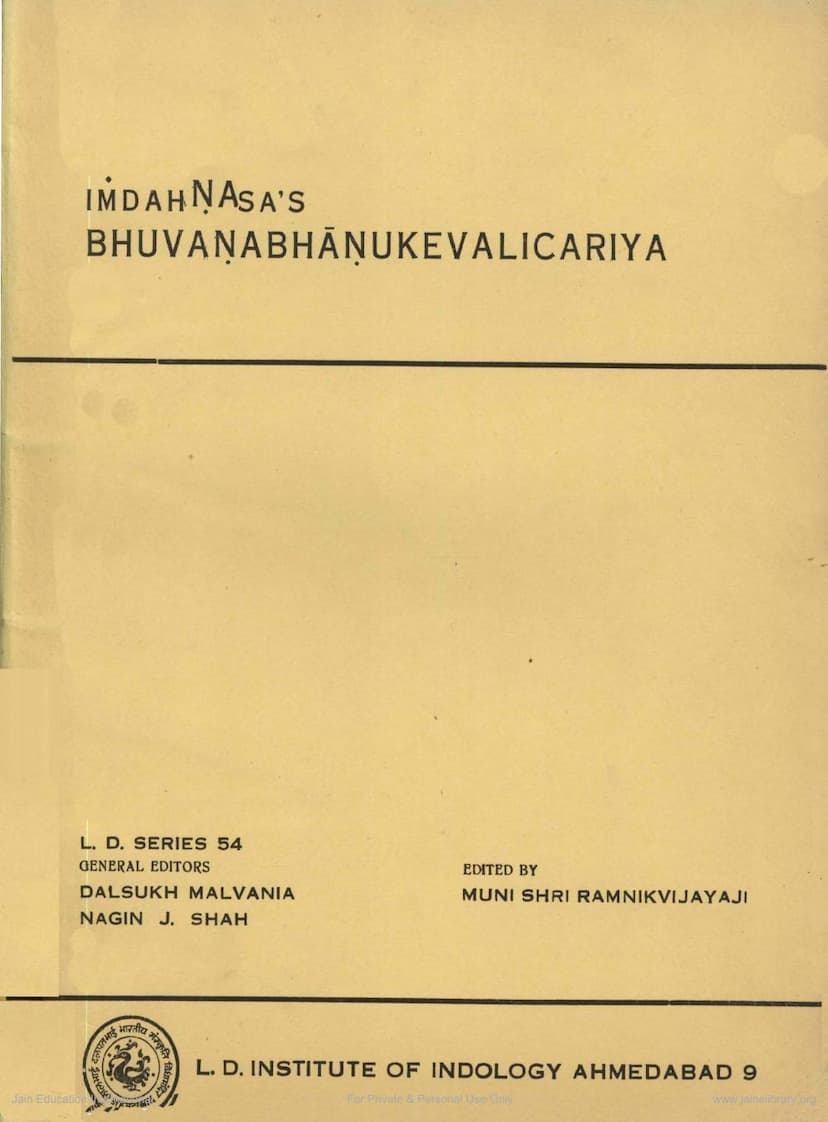Bhuvanabhanukevalicariya
Added to library: September 1, 2025

Summary
Here's a comprehensive summary of the Jain text "Bhuvanabhanukevalicariya" by Indahansagani, based on the provided information:
Book Title: Bhuvanabhanukevalicariya (also known as Balinarendracarita)
Author: Indahansagani (belonging to the Kutubapura branch of the Tapagaccha)
Date of Composition: V.S. 1554 (1498 AD)
Publisher: L. D. Institute of Indology, Ahmedabad
Language: Prakrit (versified)
Theme:
The "Bhuvanabhanukevalicariya" is an allegorical didactic story that traces the spiritual progress of the soul (Jiva). The protagonist, Bhuvanabhanu Kevali, is not a historical or mythical figure but a purely imaginative creation. The narrative follows his journey through various births, illustrating the cyclical nature of existence and the consequences of karma. The work is rich in personifications of abstract qualities, which the author has skillfully imbued with vivid personalities.
Author's Lineage:
Indahansagani belonged to a prominent spiritual lineage within the Tapagaccha, tracing back through several influential Acharyas, including:
- Yugapradhana Somasundarasuri
- Munisundarasuri
- Jayacandrasuri
- Ratnasekharasuri
- Udayanandisuri (alias Yogindra)
- Surasundarasuri
- Laksmiasagarasuri
- Somadevasuri
- Ratnamandanasuri
- Somajayasuri
- Indranandisuri
- Dharmasuri
- Vacaka Indrahamsa (the author's direct guru)
Work's Context and Influence:
- Original Inspiration: The theme of Bhuvanabhanu Kevala originated with Acharya Hemacandrasuri Maladhari (12th century AD), who composed a Sanskrit prose version within his commentary on Bhavabhavana. Hemacandra's work itself shows influence from Acharya Siddharsi's "Upamitibhavaprapanchakatha" (905 AD), a well-known Sanskrit allegory.
- Indahansagani's Contribution: Indahansagani versified Hemacandra's work into Prakrit.
- Subsequent Works: The theme continued to be explored in Jain literature:
- Lakshmilabhagani of Kharataragaccha composed a Prakrit prose version in V.S. 1603.
- Udayaratnasuri of Tapagaccha wrote a Gujarati "Bhuvanabhanukevali-rasa" in V.S. 1769.
- Tattvahsagani wrote a Gujarati commentary ("Balavabodha") on Hemacandra's Sanskrit work in V.S. 1801.
- Harikalasa also wrote a commentary on Hemacandra's work.
Content Summary (based on the narrative provided in the preface and text):
The story begins with an exposition of Bhuvanabhanu Kevala's spiritual journey, highlighting his various births and the karmic consequences he faced.
- The Protagonist's Early Life: Bhuvanabhanu, in a past life, was born as Vali, the son of King Akalanka and Queen Sudarshana of Chandrapuri in Gandhilavati Vijay of Jambudvipa. After enjoying royal splendor, he renounced worldly life upon hearing a parable about King Madhu from Kevali Kuvalayachandra.
- The Allegory of Karma: The narrative emphasizes the suffering caused by worldly attachments and the cyclical nature of rebirths in various life forms and states (hellish beings, animals, plants, celestial beings, humans). This is illustrated through the protagonist's countless births, where he repeatedly falls prey to the "enemies" of Moha (delusion) and his associates (Krodha, Mana, Maya, Lobha).
- The Struggle for Liberation: The story details the protagonist's repeated attempts to attain right faith (Samyaktva) and right conduct (Charitra), often losing these precious attainments due to the influence of passions and worldly temptations. The text describes his struggles with vices like attachment, anger, pride, deceit, greed, falsehood, theft, and violence.
- The Path to Kevalajñāna: Through persistent effort, overcoming obstacles, and adhering to the teachings of the Kevalis and virtuous gurus, the protagonist eventually progresses through the stages of spiritual purification. The narrative describes his attainment of the highest stages of spiritual development, culminating in omniscience (Kevalajñāna) and liberation (Moksha).
- The Message: The core message is the importance of spiritual discipline, detachment from worldly pleasures, unwavering devotion to the Tirthankaras and gurus, and the diligent practice of the Jain path for the ultimate goal of liberation. The allegory serves as a powerful reminder of the law of karma and the arduous yet ultimately rewarding journey of the soul towards purification and freedom.
Editorial Information:
- The text was edited by Muni Shri Ramanikvijayaji based on two manuscripts, one from the Pt. Kirtimuni Jñanakosa, Godhavi, and the other from Samvegi Upasraya, Ahmedabad.
- Both manuscripts are estimated to be from the 17th century V.S.
- The editor provided Sanskrit equivalents for difficult terms and annotations.
- The publication was supported by donations and the Trustees of Kikabhat's Pole Jaina Upashraya.
Overall Significance:
The "Bhuvanabhanukevalicariya" is a significant work in Prakrit Jain literature, offering a profound allegorical depiction of the soul's journey. It serves as both an inspiring narrative and a philosophical treatise on the principles of karma, liberation, and the means to achieve them, drawing from the rich tradition of Jain spiritual literature.